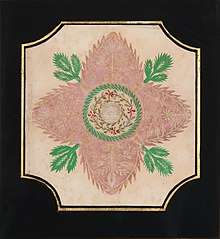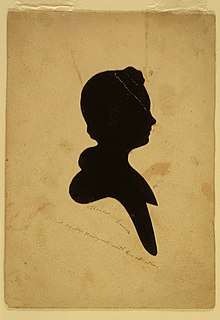Martha Ann Honeywell
Martha Ann (sometimes Anne) Honeywell (1786–1856)[1] was an American disabled artist, who produced silhouettes using only her mouth and her toes, often in public performances.


A native either of Lempster, New Hampshire,[2] or of Westchester, New York,[1] Honeywell was born without hands or forearms, and had only three toes on one foot.[2] One of her advertisements claimed she stood only three feet tall.[3] She was known for her silhouettes, paper cutouts, needlework, and penmanship. Honeywell became a public performer around the United States, displaying her talents. During one such display, recorded by diarist William Bentley, she threaded a needle and embroidered with her toes and mouth; balanced scissors with her mouth and arm stump to make paper cutouts; and wrote a letter with her toes. Besides silhouettes, another of her specialties was a cutout with a handwritten version of the Lord's Prayer at its center. Many of her public appearances are documented in newspaper advertisements and other similar documents. According to these she would perform three times a day, each show lasting two hours and costing fifty cents a ticket. One broadside indicates silhouettes would be cut in a few seconds for twenty-five cents, half-price for children. Appearances have been documented in Salem, Massachusetts, in 1806 and 1809; Charleston, South Carolina in 1808 and 1834-5; in Louisville, Kentucky, in 1839. She was in Boston in 1806.[2] In 1832 she is recorded as having appeared in Richmond, Virginia.[4] A broadside also indicates that she traveled to Europe, where her work was well-received.[5] On many occasions, Honeywell appeared in the company of another, similar disabled artist, Sally Rogers.[6]
A paper cutout by Honeywell featuring the Lord's Prayer, dating to around 1830, is in the collection of the Metropolitan Museum of Art.[7] An undated silhouette of a lady is owned by the Smithsonian American Art Museum.[8] The Abby Aldrich Rockefeller Folk Art Museum owns another cutout with the Lord's Prayer[9] as well as a broadside advertising her work.[10] Two of her silhouettes are owned by Historic Deerfield.[6] A silhouette of E. Tupper is held by the American Antiquarian Society.[11] The historical society of Montgomery County, Pennsylvania owns an example of her work as well.[12]
References
- "Disability History Association Podcast Interview with Laurel Daen December 2018" (PDF). Retrieved 2019-03-24.
- Gerard C. Wertkin (2 August 2004). Encyclopedia of American Folk Art. Routledge. ISBN 978-1-135-95614-1.
- "Silhouette Artists Born Without Arms ©". Retrieved Mar 24, 2019.
- Raleigh Lewis Wright (1983). Artists in Virginia before 1900: an annotated checklist. University Press of Virginia. ISBN 978-0-8139-0998-1.
- Daen, Laurel (May 24, 2017). "Martha Ann Honeywell: Art, Performance, and Disability in the Early Republic". Journal of the Early Republic. 37 (2): 225–250. doi:10.1353/jer.2017.0019. Retrieved Mar 24, 2019 – via Project MUSE.
- "Collections Database". museums.fivecolleges.edu. Retrieved Mar 24, 2019.
- https://www.metmuseum.org/art/collection/search/701205
- "Lady". Smithsonian American Art Museum. Retrieved Mar 24, 2019.
- "Colonial Williamsburg Online Collections". emuseum.history.org. Retrieved Mar 24, 2019.
- "Colonial Williamsburg Online Collections". emuseum.history.org. Retrieved Mar 24, 2019.
- "E. Tupper · Silhouettes: An Illustrated Inventory of the American Antiquarian Society". Americanantiquarian.org. Retrieved 2019-03-24.
- "M. A. Honeywell | Found in Collection". Retrieved Mar 24, 2019.